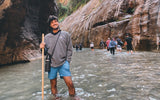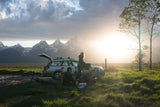Exploring Colorado: Great Sand Dunes National Park & Preserve

Contributed by Sophie Goodman; top photo by Matt Noble [unsplash]
Great Sand Dunes National Park & Preserve, a 150,000-acre National Park located in Colorado’s San Luis Valley, is flanked by the Sangre de Cristo Mountain range to its east and the San Juan Mountains to its west. Hundreds of thousands of years ago, the area that is now occupied by the tallest sand dunes in North America was once filled by a lake. As the lake evaporated, it left behind sediments, and the area’s unique geography combined with prevailing winds and sediment redistribution by waters flowing out from the mountains formed the 30-square mile dune field that lends the park its name. There are six types of dunes in the park—Reversing, Star, Parabolic, Barchan, Transverse, Nebkha—and the tallest reaches 755 feet above the valley floor.
In addition to iconic sand formations, more than 41,000 acres of wilderness are also protected within the boundaries of the National Park, including forested mountainsides, alpine lakes and streams, and a multitude of wildlife, including mule deer, elk, and black bear. The alpine terrain is not, however, all that easy to access. The two main entryways are the Mosca Pass Trail (accessed near the Visitors Center) and the Medano Pass Primitive Road (high clearance vehicle required).

Photo by Ian Dooley [unsplash]
Today, you can visit the park year-round and experience the undeniably otherworldly landscape that is Great Sand Dunes National Park & Preserve. We caught up with Eric Valencia, Acting Chief of Interpretation and Visitor Services, and Sydney Stover, Park Ranger in Interpretation and Visitor Services, to learn more about Great Sand Dunes National Park & Preserve, their passion for the land, and some of the highlights of their careers in the National Park Service.
Tell us a little bit about the history of the Great Sand Dunes National Park & Preserve. When was it established?
Eric: Great Sand Dunes National Monument was established during the Herbert Hoover administration on March 17, 1932. In November of 2000, President Clinton signed legislation that expanded the original monument boundaries and created Great Sand Dunes National Park & Preserve. On September 13, 2004, Secretary of the Interior, Gale Norton, signed the declaration formally changing the name to Great Sand Dunes National Park and Preserve.

Photo by Lionello Delpiccolo [unsplash]
How were the sand dunes formed?
Sydney: That’s a fun one. Science is helping us learn more and more as time progresses and as new discoveries are made, but at this point, we don’t have an exact date on the formation of the dunes because the dates fluctuate every time they do any kind of core sampling.
Essentially, thousands of years ago there was a lake in this valley and though the lake has since evaporated, the sediment that was at the bottom of the lake was eventually blown in with prevailing winds up against the Sangre de Cristo Mountains. The winds also blow in down three passes in the Sangre de Cristos, so the sediment eventually builds up the dunes. It is more complicated than that because we have these amazing creeks that also flow out of the Sangre de Cristos: Sand Creek to the west and Medano Creek. Both of those creeks hug the sides of the sand dunes, and they bring sediment that has blown up into the mountains back down to the base of the dunes.
Eric: The unique thing about the dunes is that they were built by an aeolian or wind-driven process, which is actually quite unique and quite fascinating.

Left: photo by Ian Dooley [unsplash]; Right: photo by Josh Gordon [unsplash]
Totally! We’re used to seeing dramatic landscapes carved mostly by water like the Grand Canyon, so it’s cool to see such drama built by wind.
Sydney: Carved by wind, but recycled by water, you could almost say. Because the water is bringing the sand back to its starting point.
Eric: And then the wind starts the process all over again. It’s interesting to note that while the dunes do move a little bit at a time, substantial movement isn’t really noticeable to the naked eye. You can study the ridgeline in historic photographs from 70-80 years ago, and it pretty much remains intact.
Sydney: It has a lot to do with the moisture content of the dunes and the fact that they’re frozen a good chunk of the year as well. The Visitors Center sits at 8,200 feet here, so we’re really high up.

Photo by Matt Noble [unsplash]
Can you tell us a bit about the human history of the park and the area
Sydney: The human history goes back several thousand years. Archeologists have found projectile points near the dunes, and they’ve also found remains of Columbian Mammoths that were hunted in the area.
One of my favorite pieces of history is that modern American Indian tribes, the Ute, in particular, used the dunes to train their horses after they had been introduced to the area in the 1600s. They would have the horses ride up the dunes, alongside the dunes, and they would build up certain muscles in the animals’ legs. Then, these tribes would cross the mountains onto the Great Plains and these horses would become prized bison hunting animals because they had trained at the dunes and at altitude.
The Great Sand Dunes was always a place for visitors. Ancient people came to visit the dunes in the better seasons, collect the different plants that were edible or medicinal, hunt the different animals that lived in and alongside the dunes and in the mountains, and then they would return to kinder territory (because we do get those strong storms and dust storms). This is a place throughout space and time where people have come to enjoy and play.

Medano Creek; photo by Pimlico27 [wikipedia]
How would you suggest a first-time visitor spend a day in the park?
Sydney: We here at Great Sand Dunes National Park & Preserve protect the tallest sand dunes in North America and with that comes limited roads. We are a hiking park and people get out on foot and they wander the sand dunes. There are no trails, no signs, no markers, and no posts once you’re out on the sand. Its wilderness at its finest.
So, get on the sand. It’s otherworldly – it’s incredible. It can be intimidating for people because again, there are no signs, there are no trails, and there are no markers. Visitors literally have the freedom to wander on foot anywhere they want, and so people tend to follow the footsteps of others until they get a little bit more relaxed, and then they’re very excited to make their own footprints in the sand.
People also sandboard and sand sled. The joke among a lot of visitors that like to sandboard is that it would be a more popular sport if there was a lift to the top. But there’s no lift, so they have to climb the steep dune faces.
Eric: I would also really encourage visitors to experience that sense of solitude that one feels once you’re in the dune field. And there can be hundreds if not thousands of people within earshot, but the dunes seem to capture the sound, and there’s this sense of solitude and silence that is incredible. To look up with the feeling of solitude and silence and see those majestic mountains that are on the horizon of this otherworldly landscape... to me, it has to be one of the most amazing experiences in the whole world.

Photo by Josh Gordon [unsplash]
Why is Leave No Trace important to you personally? And why is the larger question of public lands conservation important to you as well?
Eric: For me, it’s all about the intertwining of the human and the natural world, and the symbolism of the National Park Service arrowhead really embodies it all. We as humans have a responsibility for conservation and stewardship.
Tell me a bit about your background and how you started your career in the National Park Service.
Sydney: I’m from Spokane, WA, and I went to Eastern Washington University for my bachelor’s and master’s degrees, and I remember taking a history class long before I discovered the park service about environmental history, and I actually fell in love with the mission and the idea of the National Park Service. So, I have both a BA in anthropology and a master’s in history from Eastern Washington, but it’s very difficult getting a job in the park service. So, I did what I had to do – I applied and applied and applied, and finally I got a job as a park guide at Capitol Reef National Park in Utah, far from home, far from Spokane. But I was so excited, and I have now worked at seven National Parks in the last six years. Now, I’m a permanent park ranger at Great Sand Dunes National Park, and I’ve chosen to spend the next 30 years of my life at minimum making this mission a reality.
Eric: As far back as I can remember, I have always had a desire to work for the National Park Service. I can remember my first encounter with a National Park Service Ranger at the age of four, and I was one of the individuals that was lucky enough to grow up in a gateway community that had a national park service unit in our backyard – Pecos National Historic Park – a park that we had lots of cultural connections to. Later on in life, I had an opportunity to come on board as a student hire at Pecos.
It’s interesting because I was speaking with a new employee just the other day and remembering what it meant to don the uniform for the first time and just how honored I was to be participating in something much greater than myself and to be a small participant in that greater mission. It was also an honor to be sharing it with visitors from around the world. I ended up getting hired there at Pecos permanently after a number of seasonal positions, and I spent about 10 years at Pecos, the majority of my career. In the fall of 2014, I was asked to do a detail at the Great Sand Dunes National Park & Preserve, and what was originally a 60-day detail turned into a 10-month detail. I forged a very strong connection here to the Sangre de Cristo Mountains. I grew up in that area, and spent additional time in the sand dunes surrounding Northern New Mexico, and have wanted to return ever since. However, in the fall of 2015, I was offered a position of Chief of Interpretation at Fort Laramie National Historic Site, and I have been up at Fort Laramie for the past three years. That too has been an experience of a lifetime, through which I have become very connected to the story and the importance of the site to the history of the United States and its cultural diversity and everything that occurred there at Fort Laramie. Like many things in my life, I had the opportunity to return to Great Sand Dunes, again on a detail, and I jumped at the chance. I’ve been here now for about a month, and I’ll be here for another six weeks or so before I return to my home park at Fort Laramie.

Photo by Josh Gordon [unsplash]
What do you want visitors to leave with after they’ve visited Great Sand Dunes?
Eric: A personal connection, whether that connection be intellectual or emotional. It is that personal connection that spurs people on to be stewards of their public lands, and I feel that is the best thing I can do for any visitor that arrives here at the Great Sand Dunes.
Click here for more information about Great Sand Dunes National Park & Preserve.
Suggested Gear List: Water & food; water shoes or sandals; sand sled or sandboard; layers – long pants, insulated jacket, hat, gloves, t-shirt; sun protection – hat, sunscreen, UV protected layers, sunglasses; trekking poles; a cooler; insulated drinkware; camping gear – tent, lantern, sleeping bags, etc; a map of San Luis Valley, Colorado.

Photo by Vlad Tchompalov [unsplash]




